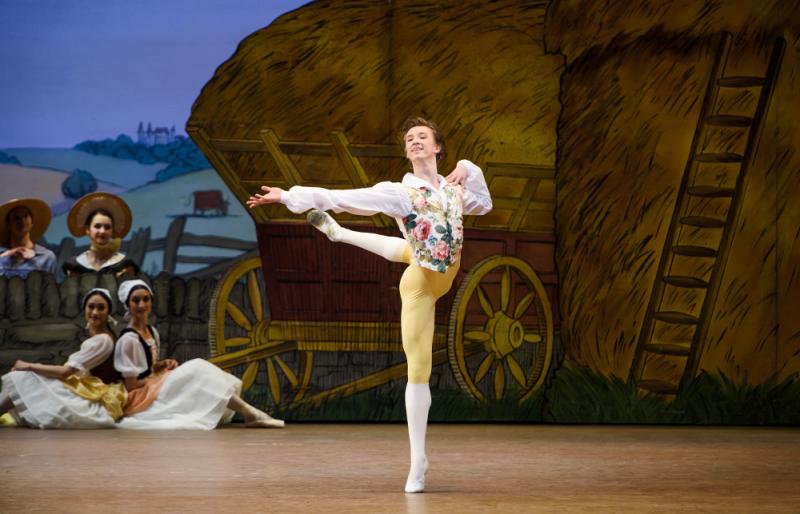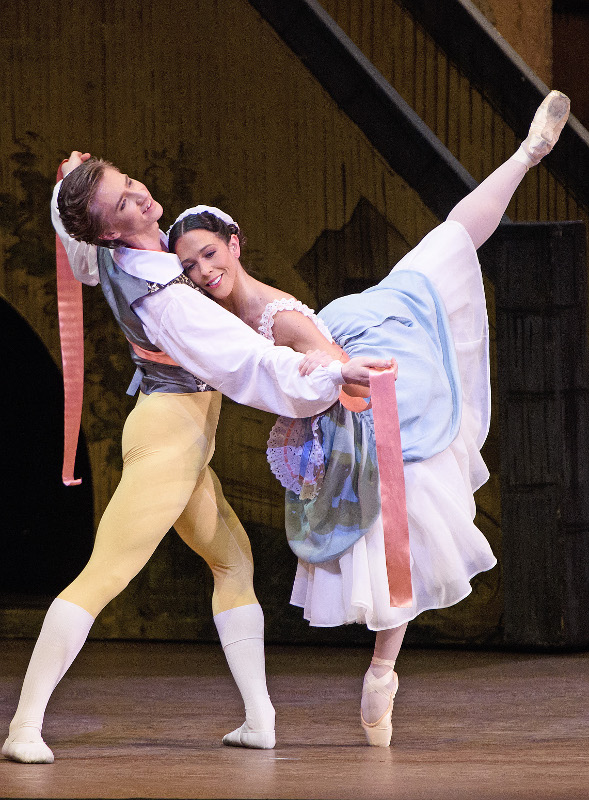La Fille mal gardée, Royal Ballet | reviews, news & interviews
La Fille mal gardée, Royal Ballet
La Fille mal gardée, Royal Ballet
Young love in yellow tights

In a world of terrifyingly serious news, the opening of the Royal Ballet season with Frederick Ashton's pastoral frolic La Fille mal gardée might seem like a wanton disregard for reality, like a brass band playing "Oh I do like to be beside the seaside" as the Titanic goes down. But that is to misunderstand the reason Fille is so beloved is that it has at its heart a perfectly serious and realistic topic: young love.
The ballet's roots are in comédie sérieuse - meaning "true to life" - and it is true to life, in a rose-tinged, shiny photo album sort of way. Most young agricultural swains do not have the aristocratically refined limbs of a Vadim Muntagirov (main picture); their farmyard sweethearts are unlikely to get away with doing as little work as Lise, the wayward daughter of the title; while field labourers with immaculate clothes, even teeth, and a lofty disinterest in being paid for work done are likewise features of strictly fictional rural idylls. But the basic story is perfectly realistic: sometimes - even quite often - it happens that a boy and a girl fall in love and manage to proceed to their desired end of marriage with no greater trial than a little mild parental disapproval and the odd hapless competitor.
Much of the joy comes from the obvious pleasure both dancers take in their parts
Young, happy lovers are what this ballet is all about: the chickens and the clog dance and the maypole and Alain with his umbrella are just frippery. They're charming frippery, of course, if you're in the right mood, but not everyone is; inevitably in every performance of Fille there are bemused spectators wondering what manner of farmyard farce they have wandered into. But the love scenes are not mood-dependent - they are mood changers, inevitable pick-me-ups. However fretted by work or midweek-exhausted you were when you arrived at the theatre, you would still be utterly transported by the tender, confident, laughingly exuberant pas de deux between Lise and Colas.
Laura Morera and Vadim Muntagirov are safe hands in these roles - both being technically able, fine actors, and cheerful souls - and "safe" here is not a euphemism for boring, any more than "comic" is a euphemism for ridiculous. This is the safety of trust - as a spectator, you trust implicitly that neither principal will put a foot wrong, that both will sparkle and impress with their technique, captivate with their smiles, and bring us to the final curtain misty-eyed with delicious romantic sentiment. Morera and Muntagirov do exactly these things, and they are no less delightful for being expected.
 Much of the joy comes from the obvious pleasure both dancers take in their parts: Muntagirov even, taking his bows after a perfectly executed set of grands jetés en tournant (with extra twiddles, natch), allows himself a wide and totally genuine smile straight to the audience, à la Sylvie Guillem. You can't help but love him, and the fact that his long limbs look so very pretty in those primrose pants and that chintz waistcoat makes it perfectly obvious that his sweetheart must think herself the luckiest girl in the world. The naturally crisp and energetic Morera plays Lise as a brisk, wily country girl whose default mode is to flirt and tease - making it therefore all the more delicious when Muntagirov's ardent danced lovemaking surprises her into sentimental abandon during the Act I ribbon pas de deux (pictured above right; one of the best love scenes in ballet).
Much of the joy comes from the obvious pleasure both dancers take in their parts: Muntagirov even, taking his bows after a perfectly executed set of grands jetés en tournant (with extra twiddles, natch), allows himself a wide and totally genuine smile straight to the audience, à la Sylvie Guillem. You can't help but love him, and the fact that his long limbs look so very pretty in those primrose pants and that chintz waistcoat makes it perfectly obvious that his sweetheart must think herself the luckiest girl in the world. The naturally crisp and energetic Morera plays Lise as a brisk, wily country girl whose default mode is to flirt and tease - making it therefore all the more delicious when Muntagirov's ardent danced lovemaking surprises her into sentimental abandon during the Act I ribbon pas de deux (pictured above right; one of the best love scenes in ballet).
The supporting cast were all on excellent form: Thomas Whitehead gives a jaunty twist to Widow Simone, while diminutive Paul Kay is a button-bright Alain, keeping this sometimes rather pitiful character comic rather than pathetic - more hobbit than half-wit. With the corps dances being mostly large, fast, and intricate, individuals don't get much chance to stand out, but the Royal Ballet dancers are on top of Ashton's fancy footwork, and inject their nameless parts with the same jaunty character that emanates from the pit as the ROH orchestra trip and trill their expert way through the Hérold/Lanchbery score.
You'll go home humming, and smiling; you might even think that the world isn't such a very terrible place really. Vive la comédie sérieuse!
- The Royal Ballet perform La Fille mal gardée at the Royal Opera House until 22 October
rating
Share this article
The future of Arts Journalism
You can stop theartsdesk.com closing!
We urgently need financing to survive. Our fundraising drive has thus far raised £33,000 but we need to reach £100,000 or we will be forced to close. Please contribute here: https://gofund.me/c3f6033d
And if you can forward this information to anyone who might assist, we’d be grateful.

Subscribe to theartsdesk.com
Thank you for continuing to read our work on theartsdesk.com. For unlimited access to every article in its entirety, including our archive of more than 15,000 pieces, we're asking for £5 per month or £40 per year. We feel it's a very good deal, and hope you do too.
To take a subscription now simply click here.
And if you're looking for that extra gift for a friend or family member, why not treat them to a theartsdesk.com gift subscription?
more Dance
 Help to give theartsdesk a future!
Support our GoFundMe appeal
Help to give theartsdesk a future!
Support our GoFundMe appeal
 Maddaddam, Royal Ballet review - superb dancing in a confusing frame
Wayne McGregor's version of Margaret Atwood's dystopia needs a clearer map
Maddaddam, Royal Ballet review - superb dancing in a confusing frame
Wayne McGregor's version of Margaret Atwood's dystopia needs a clearer map
 Pina Bausch’s The Rite of Spring/common ground[s], Sadler’s Wells review - raw and devastating
Returning dancers from 13 African countries deliver celebrated vision with blistering force
Pina Bausch’s The Rite of Spring/common ground[s], Sadler’s Wells review - raw and devastating
Returning dancers from 13 African countries deliver celebrated vision with blistering force
 Legacy, Linbury Theatre review - an exceptional display of black dance prowess
An all-too-fleeting celebration of black and brown ballet talent that demands a reprise
Legacy, Linbury Theatre review - an exceptional display of black dance prowess
An all-too-fleeting celebration of black and brown ballet talent that demands a reprise
 National Ballet of Canada, Sadler's Wells review - see this, and know what dance can do
Yet again, Crystal Pite proves herself a ferocious creative force, alongside fellow Canadian exports James Kudelka and Emma Portner
National Ballet of Canada, Sadler's Wells review - see this, and know what dance can do
Yet again, Crystal Pite proves herself a ferocious creative force, alongside fellow Canadian exports James Kudelka and Emma Portner
 Nobodaddy, Teaċ Daṁsa, Dublin Theatre Festival review - supernatural song and dance odyssey
Michael Keegan-Dolan’s genius guides us through death, separation and loss
Nobodaddy, Teaċ Daṁsa, Dublin Theatre Festival review - supernatural song and dance odyssey
Michael Keegan-Dolan’s genius guides us through death, separation and loss
 Alice's Adventures in Wonderland, Royal Ballet review - big, bold and ultimately brash
It may be box-office gold, but Christopher Wheeldon's adaptation fails to find a beating heart down the rabbit hole
Alice's Adventures in Wonderland, Royal Ballet review - big, bold and ultimately brash
It may be box-office gold, but Christopher Wheeldon's adaptation fails to find a beating heart down the rabbit hole
 Resurgence, London City Ballet, Sadler’s Wells review - the phoenix rises yet again
A new 14-strong company reviving a much-loved name is taking ballet to smaller theatres
Resurgence, London City Ballet, Sadler’s Wells review - the phoenix rises yet again
A new 14-strong company reviving a much-loved name is taking ballet to smaller theatres
 The Mad Hatter's Tea Party, ZooNation, Linbury Theatre review - a joyous celebration of differentness
Kate Prince's hip hop take on Lewis Carroll is energetic, charming and moving by turns
The Mad Hatter's Tea Party, ZooNation, Linbury Theatre review - a joyous celebration of differentness
Kate Prince's hip hop take on Lewis Carroll is energetic, charming and moving by turns
 Ballet Nights #006, Cadogan Hall review - a mixed bag of excellence
Gala enterprise, 12 months on, will be a stayer if it keeps up this level of excitement
Ballet Nights #006, Cadogan Hall review - a mixed bag of excellence
Gala enterprise, 12 months on, will be a stayer if it keeps up this level of excitement
 theartsdesk Q&A: Nina Ananiashvili, founder of the State Ballet of Georgia
Bolshoi superstar who made her name in London returns with a new generation
theartsdesk Q&A: Nina Ananiashvili, founder of the State Ballet of Georgia
Bolshoi superstar who made her name in London returns with a new generation

Add comment